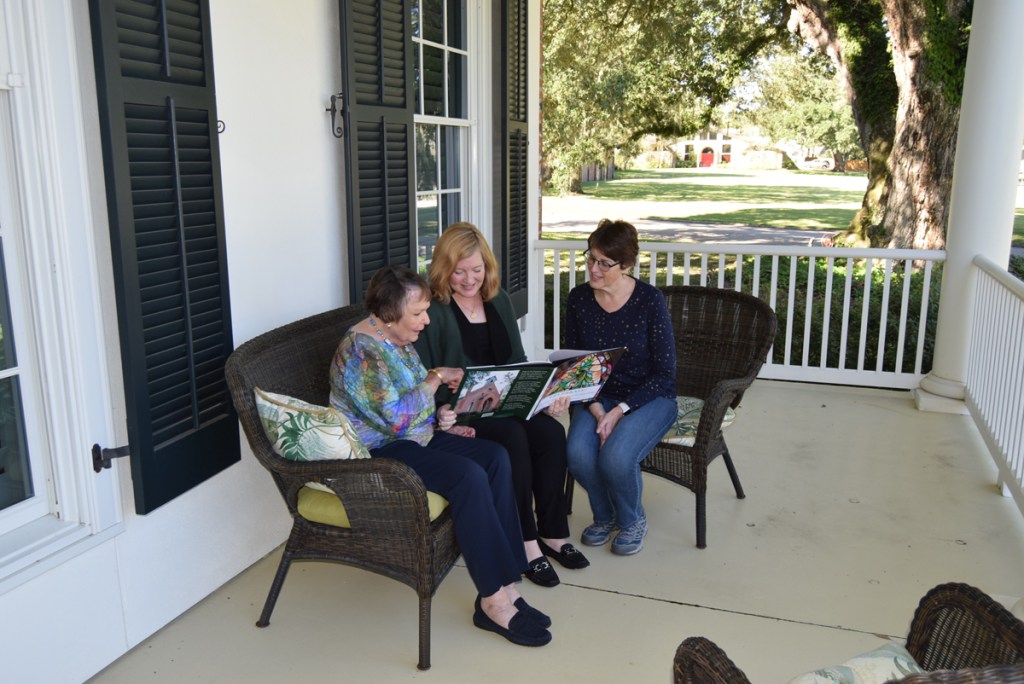Celebrating Epiphany — Family, church and community history focus of new book
Published 7:30 am Friday, October 25, 2019

- Martha Bienvenu Brown, from left, and her daughters Marjorie Brown Pierson and Rev. Ann Brown Etheredge collaborated on a pictorial history book published as a gift to the oldest public building in New Iberia. The elder Brown is the fourth generation attending The Episcopal Church of the Epiphany. The book was introduced to the congregation Sunday.
A word once commonly used in reference to great events, an epiphany is a moment of sudden revelation or insight. Further, an epiphany is a manifestation of a divine or supernatural being, specifically the manifestation of Christ, the Anointed One, to the Gentiles as represented by the Magi (Matthew 2:1–12). The annual festival commemorating The Epiphany is Jan. 6, or as those in south Louisiana know it, the start of Mardi Gras season. For the New Iberia congregation of The Episcopal Church of the Epiphany, last Sunday was a day of revealing a new fine art photography book by fourth and fifth generation members honoring their spiritual heritage. The beauty in the photography is a glimpse into the church which many well-known community leaders attend, such as Becky Collins, Paul Schexnayder, Mac Sterns, Ann, Margaret and Jeff Simon — and Martha Bienvenu Brown. To see a building, any building, landscape or portraiture through the lens of an artist, brings a new prospective and understanding to the simplicity and beauty of the subject. The Tiffany stained glass window behind the altar and the delicate polished brass filigree pulpit become spectaclar when the inspiration of the book is understood.
Martha Brown and her daughters, Marjorie Brown Pierson and Rev. Ann Brown Etheredge, presented their gift of love to the church Oct. 20. A sneak peek and visit with the women this week allowed a writer to enter the sanctuary where more than love has sustained the church for more than 150 years. This is their story.
What inspired this creative gift?
MBB — Every year I take a trip with my children and their spouses. Marjorie makes me a commemorative book of our trip with her photographs. I’m fourth generation in that church. I was baptized there in 1933. My mother, grandmother and my great-grandmother went to that church. (The late) Jerry Simon, (Judge) Ann Simon’s husband, is a cousin and he went there. The two ladies were Martha and Mary Baumgartner and they married Knights and Simons. This is our family. The Browns were Catholic, so I raised my children Catholic.
MBP — I’m a fine arts photographer, mostly coastal wetlands. My first book from 2012 was of the barrier islands in North Carolina. My next one will be Louisiana landscapes. I make everything digitally. I show in galleries and museums, I have work at the Hilliard and Ogden galleries. I started shooting after Hurricane Katrina. Galleries in New Orleans show my work and have for 10 years or so, and I make travel books for mom. Creating this book is the love for the ancestry. Old places matter. This church matters. It has been here longer than Iberia Parish.
Do you publish them yourself?
MBP — I usually use Blurb, which is what I did with this one. In 2015 I was standing in the church with my mom and thought, “This church is incredibly beautiful. I really want to start photographing it.” Eventually I told mom about the project and we decided to make it a book for the congregation to celebrate the church, its beauty and how it relates to New Iberia’s history. The photography began in 2015, and last year was when we decided to pull the trigger on it. I collected some vintage photography, researched vintage maps from the Library of Congress and The New Orleans Collection. That is the correlation between New Iberia and the church. I wanted to help commemorate the church and how it relates to New Iberia history. My sister, Ann Brown Etheredge, an Episcopal priest, did the narrative. We wanted to limit it to simple history. We gave her the pictures and maps and a direction and she wrote a beautiful essay.
How did the congregation receive it?
MBP — The pastor, Rev. Matt Woollett, knew we were working on the book. I had to go in and photograph it several times. He was supportive of the project but had nothing to do with it. We wanted to give it to the church as a gift. Mom underwrote the book, so we could donate all the proceeds to the church. We want everyone to know the church is open to any new parishioners that might want to come check it out. (The book) is like an ambassador to let the community know more about it — and to celebrate it. It is the oldest public building in New Iberia.
ABE — It’s hard to sum up something that has been so formative for me in one page. We were raised in the Catholic church, but I don’t think I walked into (Epiphany) except for weddings. Well, I was a pre-K student at Epiphany Day School. I heard my call to ministry there and preached my first sermon. I also was interim pastor at Epiphany. At one time I was the oldest EDS graduate on staff. I know from experience that Epiphany is a welcoming and empowering place of worship for all.
How did you get started with photography?
MBP — After graduation from Mt. Carmel, at 18 I moved away from New Iberia. I went to the University of North Carolina at Chapel Hill and majored in international studies. I took a couple of photography classes, but never thought I’d be an artist. That was not my plan. I moved to Washington D.C. and worked with the former personal photographer to President Reagan and the White House. It was fascinating, and I learned a lot about photography. I did some projects for nonprofits, Greenpeace, that sort of thing. I went to business school and then worked in the family business in Europe for years. Went back to New York, met my husband, married at Epiphany, had a baby and moved back to North Carolina. In 2005, the year Hurricanes Katrina and Rita hit, I had worked on a book called, “The Homeless in America,” documenting homelessness in the U.S. It was corporate sponsored and we did a traveling exhibition, book and shows. That was my introduction to the power of photography. I realized photography can be a powerful way to share visual narrative, particularly on a challenging subject.
The next project you’re working on is Louisiana landscapes. How did that come about?
MBP — After Katrina and Rita, I wanted to show Louisiana and how it survived and thrives through landscapes. That’s what made me start photography again. I began with pictures I made in New Iberia, abstract landscapes. Someone gave me a show and I decided to start building a portfolio of Acadiana wetlands pictures. I’m having my fourth show in New Orleans in May. That’s what started me out. Over the last 14 years I’ve become an environmental photographer. That’s what I am.
Where can people buy the book?
MBP — In a couple of weeks it will be available at the church, but I’ll be back from North Carolina for a book signing at Books Along the Teche Bookstore the Friday after Thanksgiving, from 4 to 6 p.m. That’s our public reception. What we did on Sunday was the church reception, so they could get the first look at the book. It’s been a nice way to reconnect people with the church that have moved away.





